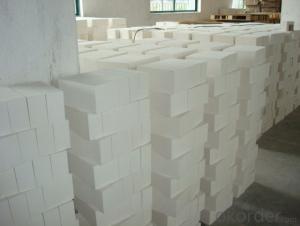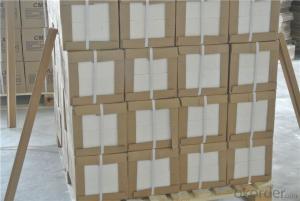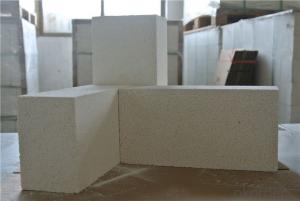Fire Light Mullite Insulation Brick Product
- Loading Port:
- Shanghai
- Payment Terms:
- TT OR LC
- Min Order Qty:
- 1 m.t.
- Supply Capability:
- 10000 m.t./month
OKorder Service Pledge
OKorder Financial Service
You Might Also Like
Thermal Insulation Fire Clay Brick
Refractory brick is a refractory material used in lining furnaces, kilns, fireboxes, and fireplaces.
We provide high quality Refractory Fire Bricks that are used on wide range in the various industries like Cement, Glass and Steel. Refractory Fire Bricks are provided as per the quantity and specifications required by the customers. We provide an extensive range of Refractory Fire Bricks at reasonable prices that depend upon the quantity ordered.
Application
Insulating Fire Brick are used for the lining of converter, alternating current arc furnace, direct Current arc furnace and the ladle slag line, etc.
Company Advantage
(1)Long Insulating Fire Brick manufacture history: 25 years manufacturer
(2)Advanced equipment and good service
(3)Diversification of production standards: ISO ANSI FEPA JIS ASTM
(4)Flexible payment: T/T L/C D/P D/A
(5)Professional marketing team and after-sale service
Insulating Fire Brick main feature:
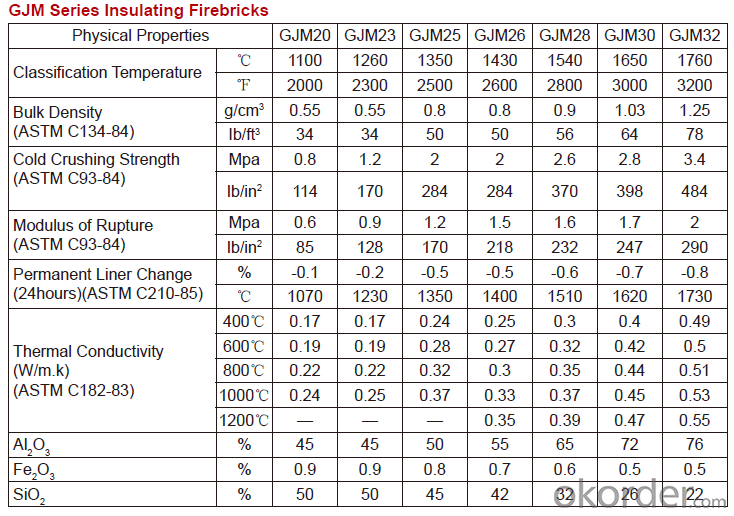
Equipment
1 unit of Ceramic Abrasive (SG Abrasive) pilot production line
2 units of Compact grain Abrasive pilot production lines
1 unit of high-end coated abrasives (abrasive cloth) production line
3 large flexible crushing and sieving lines for grit production lines
6 units of 5000KVA-10000KVA dumping type electric arc furnaces for Brown Fused Alumina fusion
FAQs
Q1 What’s the transport method?
A1 FCL delivery goods with wooden pallet or wooden case by sea; If LCL delivery, must with wooden case; Sometimes need open top, flat rack or bulk cargo.
Q2 What’s the required payment term?
A2 Generally 30% TT as the prepayment, 70% TT before delivery. If need, 100% Irrevocable Letter of Credit or negotiation.
Q3 Which country are our products exported to?
A3 Apart from entire Chinese market, the US, Russia, Japan, Korea, Australia and some Southeast Asian Nations.
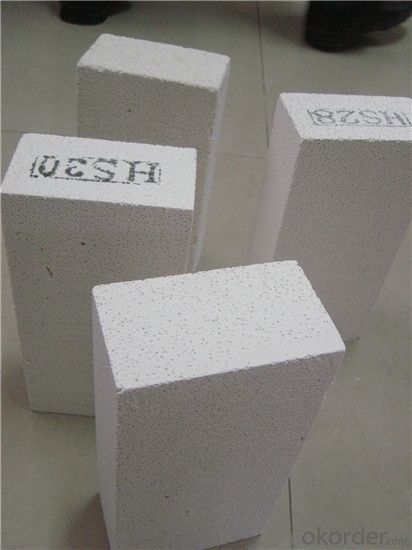

- Q:Can insulating fire bricks be used in the construction of hearths?
- Indeed, hearths can be constructed using insulating fire bricks. These bricks are specifically engineered to endure extreme temperatures, rendering them a superb selection for hearth construction. With their low thermal conductivity, they effectively retain heat and hinder the transmission of heat to nearby surroundings. Consequently, they are perfect for establishing a well-insulated and efficient hearth. Furthermore, their lightweight and manageable nature make them highly convenient for construction tasks. All in all, insulating fire bricks prove to be a dependable and pragmatic choice for the development of hearths.
- Q:Do insulating fire bricks expand and contract with temperature changes?
- Insulating fire bricks do indeed undergo expansion and contraction in response to temperature variations. Similar to all other materials, exposure to heat causes these bricks to expand, whereas cooling leads to their contraction. This expansion and contraction phenomenon arises from the material's thermal expansion coefficient, which dictates the degree of expansion or contraction in relation to temperature changes. It is crucial to acknowledge this characteristic when utilizing insulating fire bricks in situations that involve anticipated temperature fluctuations. Neglecting to account for the expansion and contraction may result in structural harm or the formation of cracks.
- Q:Can insulating fire bricks be used as a lining for chimneys?
- Yes, insulating fire bricks can be used as a lining for chimneys. These bricks are designed to withstand high temperatures and provide insulation, making them suitable for lining chimneys and protecting them from heat damage.
- Q:Are insulating fire bricks resistant to acid attack?
- Insulating fire bricks are known for their resistance to acid attack. They are manufactured using durable materials that can withstand high temperatures and offer excellent insulation properties. These bricks are typically composed of lightweight refractory materials like alumina, silica, and other refractory oxides, which are renowned for their ability to resist chemical corrosion, including acids. Nevertheless, it is crucial to acknowledge that the acid resistance of insulating fire bricks can vary depending on their specific composition and manufacturing process. Some bricks may exhibit higher resistance to acids than others. Therefore, it is advisable to consult the manufacturer or supplier for detailed information regarding the acid resistance of their insulating fire bricks. Generally, insulating fire bricks are widely used in various applications where they may encounter acids, such as industrial furnaces, kilns, and high-temperature environments. They are valued for their durability and capacity to withstand harsh chemical surroundings, including acid exposure. However, it is always essential to consider the precise chemical composition and concentration of the acids involved, as well as the temperature conditions, to determine the suitability of insulating fire bricks for a particular application.
- Q:Can insulating fire bricks be used in ceramic industry kilns?
- Yes, insulating fire bricks can be used in ceramic industry kilns. Insulating fire bricks are specifically designed to withstand high temperatures and are capable of providing insulation in kilns. They have low thermal conductivity, which helps to maintain consistent heat distribution within the kiln, resulting in more efficient firing processes. Additionally, insulating fire bricks are lightweight, making them easier to handle and install in kilns. Their ability to retain heat and resist thermal shock makes them an ideal choice for use in ceramic industry kilns.
- Q:Can insulating fire bricks be used in the construction of reheat furnaces?
- Indeed, reheat furnaces can utilize insulating fire bricks in their construction. These bricks possess the capability to endure elevated temperatures and offer exceptional insulation, rendering them exceptionally suitable for furnaces. With their low thermal conductivity, insulating fire bricks aid in diminishing heat loss and enhancing energy efficiency within the furnace. Moreover, they exhibit remarkable resistance to thermal shock, enabling them to withstand swift temperature fluctuations encountered during the reheat procedure. All in all, insulating fire bricks emerge as a fitting option for reheat furnace construction, as they foster improved heat retention and energy conservation.
- Q:Are insulating fire bricks resistant to sulfates?
- Insulating fire bricks are generally resistant to sulfates. These bricks are made of high-alumina or silica materials, which have good chemical resistance properties. Sulfates are a type of chemical compound that can react with certain materials and cause degradation. However, insulating fire bricks are designed to withstand high temperatures and harsh chemical environments, including exposure to sulfates. They are often used in applications such as furnaces, kilns, and incinerators where they may come into contact with sulfates. Nevertheless, it is important to consider the specific composition and quality of the insulating fire bricks, as well as the concentration and duration of sulfate exposure, to ensure their long-term performance and durability.
- Q:Can insulating fire bricks be used for insulation in industrial chimneys?
- Indeed, insulating fire bricks have the capability to serve as insulation in industrial chimneys. These bricks are specially crafted to endure extreme temperatures and offer exceptional insulation characteristics. Comprised of lightweight refractory materials boasting low thermal conductivity, insulating fire bricks successfully retain heat and hinder its dispersion into the environment. Consequently, they prove to be optimal for employment in industrial chimneys, as insulation plays a vital role in diminishing heat loss and enhancing energy efficiency. Furthermore, insulating fire bricks exhibit resistance against chemical corrosion, rendering them well-suited for the hostile and corrosive settings frequently encountered in industrial chimneys.
- Q:Can insulating fire bricks reduce heating or cooling costs?
- Insulating fire bricks possess the ability to decrease heating or cooling expenses. These bricks are specially designed to exhibit a high level of thermal insulation, meaning they possess low thermal conductivity and can effectively hinder the transfer of heat between a building's interior and exterior. In the construction of fireplaces, ovens, or kilns, the utilization of insulating fire bricks aids in retaining heat within these structures. This enables them to achieve and maintain higher temperatures while consuming less energy. Consequently, this leads to substantial savings on heating costs, as the desired temperature can be achieved with reduced energy usage. Similarly, when employed in the construction of walls, insulating fire bricks serve to minimize heat transfer between a building's inside and outside. This results in decreased heating or cooling requirements, as the insulation helps to maintain a consistent indoor temperature. Subsequently, less energy is needed to heat or cool the building, resulting in lower energy bills and reduced overall heating or cooling expenses. It should be noted that the effectiveness of insulating fire bricks in reducing heating or cooling costs can vary based on factors such as overall building insulation, structure size and design, and climate conditions. Nevertheless, in general, the utilization of insulating fire bricks can contribute to energy efficiency and cost savings in heating or cooling systems.
- Q:Can insulating fire bricks be used as insulation in walls and roofs?
- Insulation in walls and roofs can be achieved by utilizing insulating fire bricks. These bricks are constructed from lightweight materials that possess exceptional thermal insulation properties. Their thermal conductivity is low, allowing them to effectively minimize heat transfer through walls and roofs. Consequently, they are a fitting selection for enhancing energy efficiency and insulating buildings. Furthermore, insulating fire bricks are both long-lasting and fire-resistant, rendering them a secure choice for insulation. Nevertheless, it is crucial to acknowledge that these bricks are typically employed in high-temperature environments such as furnaces and kilns. Thus, they might not be the most economical or practical option for all wall and roof insulation requirements. In terms of cost, installation ease, and overall performance, other insulation materials specifically designed for building applications may be more appropriate.
1. Manufacturer Overview |
|
|---|---|
| Location | |
| Year Established | |
| Annual Output Value | |
| Main Markets | |
| Company Certifications | |
2. Manufacturer Certificates |
|
|---|---|
| a) Certification Name | |
| Range | |
| Reference | |
| Validity Period | |
3. Manufacturer Capability |
|
|---|---|
| a)Trade Capacity | |
| Nearest Port | |
| Export Percentage | |
| No.of Employees in Trade Department | |
| Language Spoken: | |
| b)Factory Information | |
| Factory Size: | |
| No. of Production Lines | |
| Contract Manufacturing | |
| Product Price Range | |
Send your message to us
Fire Light Mullite Insulation Brick Product
- Loading Port:
- Shanghai
- Payment Terms:
- TT OR LC
- Min Order Qty:
- 1 m.t.
- Supply Capability:
- 10000 m.t./month
OKorder Service Pledge
OKorder Financial Service
Similar products
New products
Hot products
Related keywords
